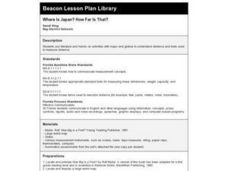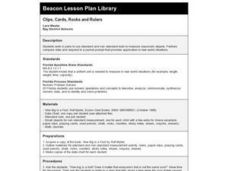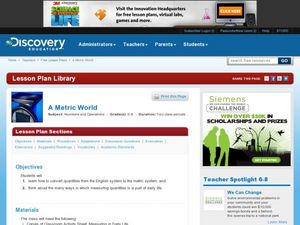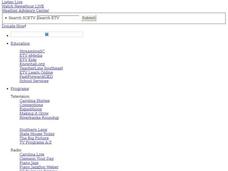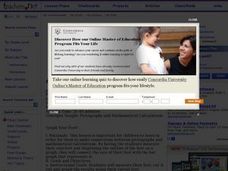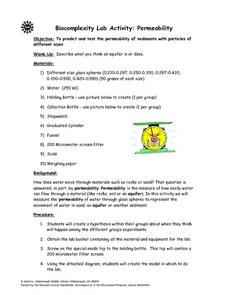Curated OER
Where Is Japan? How Far Is That?
First graders use literature and hands-on activities with maps and globes to explain distance and tools used to measure distance. They select tools to measure various objects in the classroom, then apply those concepts to their map...
Curated OER
North Carolina Pottery
Pupils examine the process of evaporation. They observe how when clay dries, the water evaporates and how the weight of the object decreases. They complete a worksheet to complete the lesson.
Curated OER
How Do Things Fall?
Students observe falling objects. They discover the rate of falling is based on air resistance and not the weight of the objects. They discuss how engineers use this type of information to design aerodynamic shapes.
Curated OER
Swinging on a String
Students explore how pendulums work and why they are useful in everyday applications. In a hands-on activity, they experiment with string length, pendulum weight and angle of release.
Curated OER
Clips, Cards, Rocks and Rulers
First graders use standard and non-standard tools to measure classroom objects. Partners compare data and responds to a journal prompt that provides application to real-world situations.
Curated OER
Angles: Angles, Angles, Everywhere
Students estimate and accurately measure the size of angles communicate with the appropriate geometric terms and symbols to describe and name angles, lines, line segments, rays
Curated OER
The Great Cover Up!
Students use non-standard measurement tools such as body parts, beans and counters to find the area of shapes drawn on the floor. They continue to determine the area of other objects in the classroom.
Curated OER
Computer Science: Pendulum
Students investigate the basic properties of pendulums as a function of spreadsheets. Working in groups, they measure the period for a pendulum at six different lengths and record the results. They prepare a file using Microsoft Excel...
Curated OER
A Metric World
Students convert English to metric units. In this math instructional activity, students give examples of measurements they encounter in their daily lives. The share their answers in class.
Curated OER
Traveling to Japan: Which Way Do We Go?
Fourth graders explore the different types of ways to measure the distance between Florida and Japan.
Curated OER
Specific Gravity of Nevada Minerals
Students determine the specific gravity of Nevada minerals by testing them three separate times. They follow specific directions listed in the lesson plan as how to measure the minerals.
Curated OER
How Many Strips?
Second graders investigate the measurement of 1 meter. They predict and measure how many strips of paper it takes to make exactly one meter. Students devise and use problem solving strategies to solve the problem.
Curated OER
Oxygen: What a Gas!
Eighth graders explain how oxygen reacts to other elements. They also explain why oxygen is a reactive substance, how it has weight, and how it reacts with other substances. They construct an experiment to relate their findings.
Curated OER
Look Mom, No Wings!
Learners explain how drag, weight, lift and thrust work together to make something fly. For this physics lesson, students measure their jump height and record data on the table. They reason out why they can't remain airborne for long.
Curated OER
How far is a km?
Students explore the size of a kilometer and the time it takes to cover this distance. They develop a concept of a km. They measure a distance of 1 km and the time taken to cover it.
Curated OER
Block and Tackle
Students simulate block and tackles to lift heavy objects. They lift cargo by hand with the whip and the two-fold purchase to simujlate what crew members do aboard ships. They measure the effort and distance pulled for a gun tackle, luff...
Curated OER
Graph Your Foot!
Students measure their own foot and place the outline on a graph. They make connections between the size of their foot and the bar graph that represents it.
Curated OER
Capturing the Wind
Students collect and analyze data about wind speed. They build a Lego wind sail and measure the wind speed with a rotation sensor. They use software to analyze the data.
Curated OER
Biocomplexity Lab Activity: Permeability
Students identify how water moves through materials such as rocks or sand. Students measure the permeability of water through glass spheres to represent the movement of water in sand, an aquifer, or another sediment. During the...
Curated OER
Simple Machines/Technology
Third graders examine the concept of work as the movement of an object through a distance. They define gravity and determine what type of work is caused by gravity. They measure how far an object is moved by a force. They make a...
Curated OER
Efficiency Means Getting More for Less
Students measure water and make predictions about efficiency.
Curated OER
A Visit to Southern Africa - Volcano
Students examine a cookie that represents pumice and lava in order to realize that lava is a composite of many rock particles. They compare and contrast pumice to the cookie by estimating, weighing, measuring and dissecting the cookie...
Curated OER
Star Power! Discovering the Power of Sunlight
Students estimate the energy output of the sun. They estimate how much power sunlight the sunlight provides to the earth. They build a simple device to measure the amount of solar radiation the earth receives from the sun.
Curated OER
Roller Coasters in the Classroom
Students define kinetic energy and know the effects of weight and speed on momentum. In this investigative lesson students get into groups and design a roller coaster.
Other popular searches
- Measuring Weight in Grams
- Measuring Weight and Mass
- Measuring Weight Scale
- Measuring Weight Pounds
- Measuring Weight in Pounds
- Measuring Weight and Volume
- Measuring Weight Shopping
- Measuring Weight in Ounces
